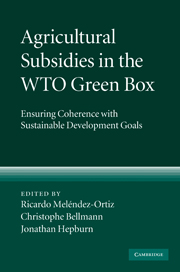Book contents
- Frontmatter
- Contents
- List of contributors
- Preface
- Acknowledgements
- List of abbreviations
- 1 Overview
- PART I The recent evolution of agricultural trade policy reform
- PART II The focus, extent and economic impact of green box subsidies
- PART III Green box subsidies and developing countries
- PART IV Green box subsidies and the environment
- 15 The environmental impact of green box subsidies: exploring the linkages
- 16 The environmental impact of EU green box subsidies
- 17 The environmental impact of US green box subsidies
- 18 Biofuels subsidies and the green box
- PART V Looking forward: how can change take place?
- Appendix: Text of Annex 2 of the WTO Agreement on Agriculture (“the green box”)
- Index
- References
15 - The environmental impact of green box subsidies: exploring the linkages
from PART IV - Green box subsidies and the environment
Published online by Cambridge University Press: 03 May 2010
- Frontmatter
- Contents
- List of contributors
- Preface
- Acknowledgements
- List of abbreviations
- 1 Overview
- PART I The recent evolution of agricultural trade policy reform
- PART II The focus, extent and economic impact of green box subsidies
- PART III Green box subsidies and developing countries
- PART IV Green box subsidies and the environment
- 15 The environmental impact of green box subsidies: exploring the linkages
- 16 The environmental impact of EU green box subsidies
- 17 The environmental impact of US green box subsidies
- 18 Biofuels subsidies and the green box
- PART V Looking forward: how can change take place?
- Appendix: Text of Annex 2 of the WTO Agreement on Agriculture (“the green box”)
- Index
- References
Summary
Introduction
Over the past decade, the WTO AoA has overseen significant reductions in the most trade-distorting forms of agricultural support. As WTO members continue reform in this direction, attention is being redirected towards forms of agricultural subsidy contained in the so-called green box (Annex 2) of the AoA. Anyone concerned with the environmental impacts of agriculture should welcome this development, as the most trade-distorting kinds of agricultural subsidy are often those that create the strongest incentives for increasing output, intensifying agricultural activities and thus adversely affecting the environment.
The shift from more to less trade-distorting forms of agricultural support can be seen both in the significant increases of green box subsidies during the implementation period of the AoA and in the very large total volume of green box subsidies today. In the US, green box subsidies nearly doubled, from US$26,151 million in the period 1986 to 1988 to US$50,057 million in 2000. Accounted for partly by the entry of three new members following the period 1986 to 1988, green box expenditure by the EU grew from €9.2 billion to €22.1 billion in 2000. The latter figure is equivalent to roughly half of all EU spending on amber box subsidies for that year. In Japan, green box subsidies represented nearly 24 per cent of its total subsidies in 2000. Given the sheer size of green box subsidies across the OECD economies, it is hard to imagine that its environmental impacts are insignificant.
- Type
- Chapter
- Information
- Agricultural Subsidies in the WTO Green BoxEnsuring Coherence with Sustainable Development Goals, pp. 427 - 467Publisher: Cambridge University PressPrint publication year: 2009
References
- 1
- Cited by



